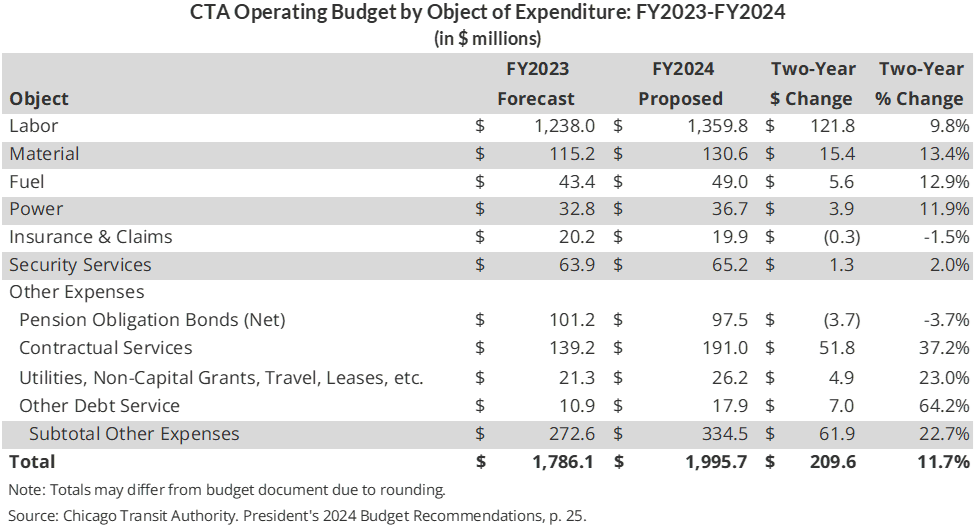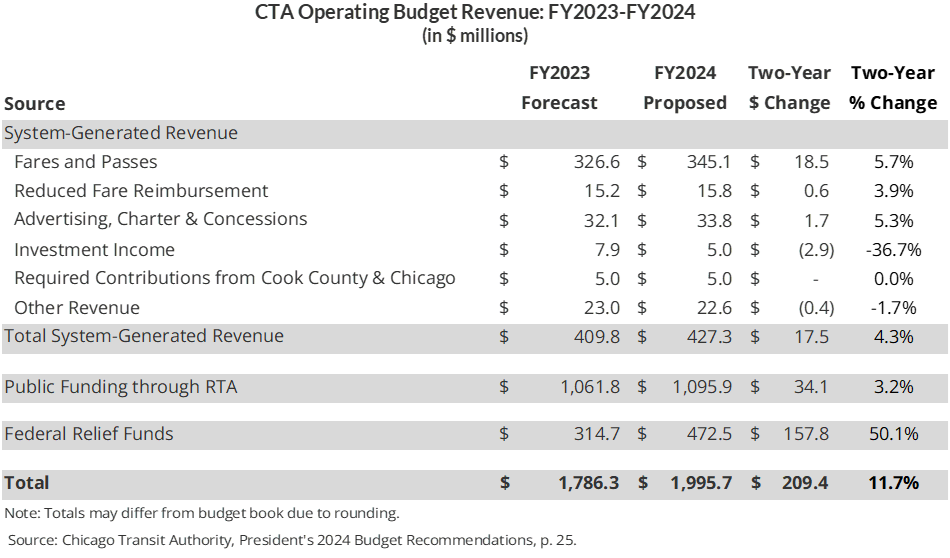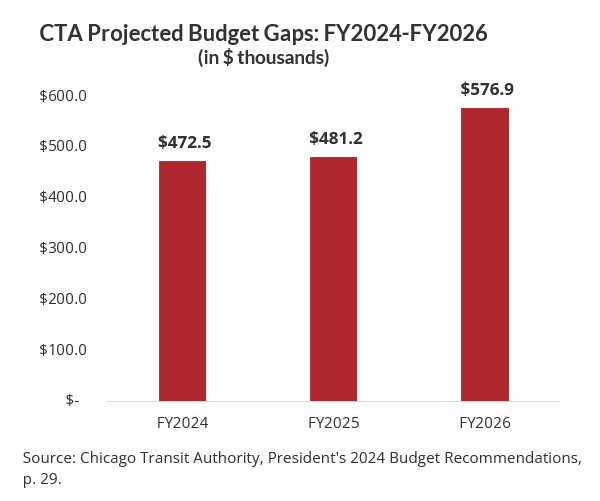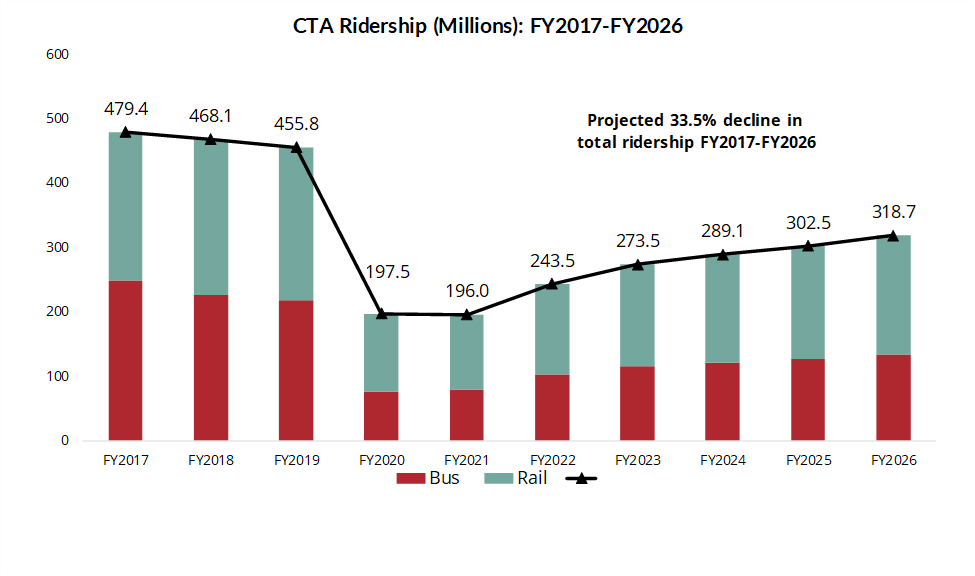December 15, 2023
This blog post presents an overview of the Chicago Transit Authority (CTA) FY2024 operating budget. The CTA’s fiscal year is January 1 through December 31.
Federal funds have been critical in maintaining transit service in the Chicago region since the onset of the COVID-19 pandemic. The FY2024 CTA operating budget is balanced with $472.5 million in federal COVID relief funds, representing approximately 23.7% of the entire operating budget. The FY2025 projected budget gap of $481.2 million will also be balanced with federal relief funds. However, those funds will be exhausted in the following year, forcing the CTA to balance its projected FY2026 budget deficit of $576.9 million by securing new additional revenue sources, making severe service cuts or utilizing some combination of both strategies.
In order to prepare for the loss of federal funds for Chicago area transit agencies in 2026, the General Assembly approved Public Act 102-1028 in 2023. The Act required the Chicago Metropolitan Area for Planning (CMAP) to convene regional stakeholders to develop recommendations for the long-term fiscal and operational sustainability of the CTA, Metra and Pace. The Plan of Action for Regional Transit (PART) report is now available in draft form and will be presented to the General Assembly in January 2024 for its consideration.
CTA FY2024 Operating Budget Totals $2.0 Billion
The Chicago Transit Authority FY2024 operating budget of nearly $2.0 billion was approved by the Chicago Transit Authority (CTA) Board on November 15, 2023. It was approved by the Regional Transportation Board on December 14, 2023.
The budget is an 11.7%, or $210.0 million, increase from the previous budget of $1.8 billion. Approximately 68.1% of the budget, or $1.4 billion, is earmarked for personnel-related expenses. The next largest individual line item is for contractual services, at $191.0 million. The 37.2%, or $51.8 million increase in this line item is driven primarily by costs associated with a Ventra card upgrade, inflation and normal cost escalations. A 13.4%, or $15.4 million, increase for materials is driven by inflationary pressures on costs for goods and parts as well as expenses for cleaning supplies and protective equipment for employees. There is a projected operating budget gap of $472.5 million that will be covered by federal relief funds.

The FY2024 CTA budget is funded from three major sources:
System generated revenues: Fare and pass revenue from CTA bus and train customers is the largest source of system generated revenues, with $345.1 million, or nearly 81.0% of the total amount of $427.3 million budgeted in FY2024. Smaller amounts will come from advertising, concessions, contributions from the City of Chicago and Cook County and other revenues.
Under the provisions of the Regional Transportation Authority Act, the CTA is required to fund 50% of its expenses through system generated revenues. However, the Illinois General Assembly reduced the recovery ratio from 2021 through 2026 to help compensate for reduced fare and pass revenues due to sharp drops in ridership resulting from the pandemic. Between 2023 and 2026, the recovery ratio has been set at 42.0%, inclusive of federal relief funds and budget balancing actions.
Public funding through the Regional Transportation Authority: These funds include revenue from the regional sales tax authorized for transit in northeastern Illinois as well as real estate transfer tax revenues and public transportation funds. In FY2024 public funding will provide nearly $1.1 billion, an increase of 3.2% from the prior year.
Federal relief funds: The CTA projects a FY2024 funding gap of $472.5 million, or 23.7% of the total operating budget. This amount will be covered by federal relief funds.

CTA Budget Gaps: FY2024-FY2026
The CTA has received a total of over $2.0 billion in federal relief funds since 2020 that it has used to balance its operating budgets. The CTA’s annual deficits during this period have been caused by declines in ridership-related revenues such as fares and passes, as well as increased expenses. These federal funds were provided through:
- The Coronavirus Aid Relief and Economic Security (CARES) Act – $817.5 million;
- The Coronavirus Response and Relief Supplemental Appropriations (CRRSA) Act – $361.3 million; and
- The American Rescue Plan (ARP) – $912.1 million.
As of July 2023, the CTA had used $1.1 billion of these funds. The remaining amounts will be used to cover budget gaps in FY2024 through FY2025. These projected gaps will rise from $472.5 million in the upcoming fiscal year to $576.9 million in FY2026 after the federal relief funds are exhausted in FY2025. The CTA will be required to seek additional revenue sources, impose severe service cuts or utilize some combination of both strategies to balance its budget in that year and each succeeding year going forward.

CTA Ridership Declines
As noted above, the CTA’s system generated revenues are derived primarily from bus and train fares. However, transit ridership has been severely impacted by the COVID-19 pandemic. Total ridership in FY2024 is projected to be approximately 63.4% of ridership in the pre-pandemic year of FY2019 and 60.3% of ridership from FY2017. While ridership is projected to increase in FY2024 to a total of 289.1 million unlinked rides, this is still a 33.5% decline from FY2017, a decrease of 160.7 million rides.

